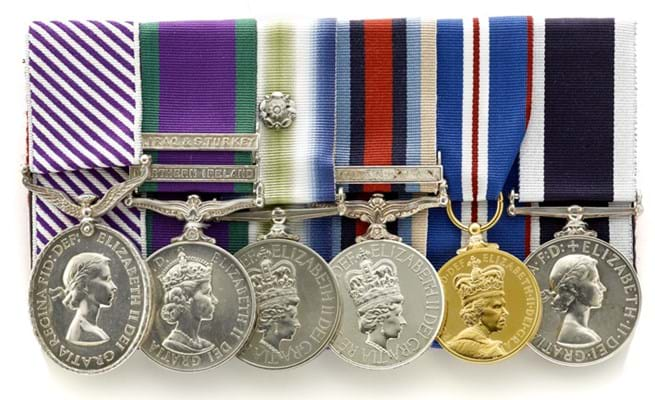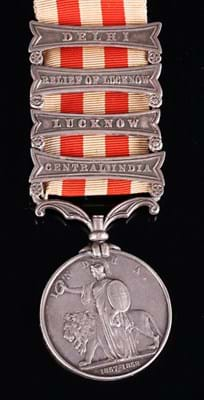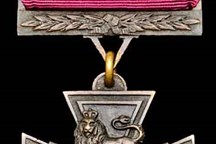British awards and decorations have many fascinating stories. There are two major categories: campaign medals and gallantry medals.
Campaign medals are awarded to members of the British Armed Forces, Allied forces and civilians participating in specified military campaigns. More than 80 different medals have been issued since the first (the Peninsular Gold Medal) was awarded to officers in 1810, with five new medals already awarded in the 21st century.
Gallantry medals recognise personal accomplishments by members of the British armed forces or acts of civilian bravery - each one with a remarkable story of heroism.
What Do People Collect?
Collectors typically focus on medals issued by their own country. In the United Kingdom the selection is huge and there are no restrictions on their sale (as there are in the USA). The Napoleonic, Crimean and Boer Wars, the Indian campaigns followed by the First World War and ensuing major 20th century British armed conflicts (18 different campaign medals were issued in the Second World War alone), divide the collecting field.
There are those who focus on certain regiments, specific military campaigns and even single decorations of the highest order, such as the Victoria Cross.
Rarities are always prized (short lived campaigns with comparatively few combatants, such as the Falklands conflict, tend to mean fewer medals) while additional bars (especially those for a well-known engagement or battle) can boost demand. These come notably into play for Crimean and Boer War medals.

This General Service Medal 1918-62 was awarded to Captain Richard Burbury. He was commanding the 1st Bn South Lancashire Regiment as lieutenant colonel on D-Day, June 6, 1944, when he was killed in action by a sniper’s bullet. The General Service Medal 1918-62 awarded to him with a Palestine clasp and Mentioned In Despatches oakleaf was estimated at £100-150 at Tennants’ Militaria & Ethnographica Sale on June 5, 2019. It sold for a hammer price of £3200 (plus 20% buyer’s premium).
The comparatively recent move to scrap distinctions between awards made to officers and other ranks has also limited the availability of some medals. One example of this is the Distinguished Flying Medal, the other ranks' equivalent of the Distinguished Flying Cross. Established in 1918 and discontinued in 1993, these were awarded in such small numbers after the Second World War that they have become highly sought after.
It was once highly controversial for recipients to sell their own medals, but in the past five years or so it has become more common, with heroes of Afghanistan and Iraq, among others, putting their awards up for sale to raise money.
Again these have rarity value, either because they are newly created awards or because so few are for sale. When in September 2010, Private Paul Darren Wilmott sold the Conspicuous Gallantry Cross he had won just three years earlier for outstanding bravery in action against the Taliban, only 30 had ever been awarded. It took £42,000 at Bosleys of Marlow.
Outside the military, acts of civilian bravery attract a plethora of medals, the highest ranking being the George Cross (effectively the equivalent to the military's Victoria Cross) instituted in 1940 to recognise the role of non-combatants on the Home front during the Blitz. In this field, it is very much the association of the particular medal which dominates pricing.
The Market
In general terms, what makes a medal worth just a few pounds or a six-figure sum is much the same as objects in other collecting fields - rarity, provenance and condition. Design is much less important and it is not often that the materials from which they are made have any intrinsic worth - the Victoria Cross, for example, are traditionally thought to be cast in gunmetal from Russian cannon captured at the siege of Sevastopol.
Within these general parameters, however, there is a huge spectrum of factors to consider from the level of gallantry of the recipient, the fame of an action or campaign and the status of the individual concerned. Medals are typically sold in groups, and the combination of decorations can add to their rarity and attraction.
Waterloo medals offer an excellent summary of the sorts of factors that can affect price. It was the first medal created since the one issued by Cromwell for the Battle of Dunbar in 1650. It was given to all participating soldiers and a total of 39,000 were awarded in 1816-17.
Accordingly, an infantry medal is scarcer than an artillery medal and a cavalry medal rarer still. Make that a medal from one of the leading horse regiments, such as the Dragoons, Life Guards or Horse Guards, and then from a senior officer, and the value climbs further.

A 12-medal group awarded to Vice Admiral Sir Humphrey Walwyn (1879-1957) whose illustrious career in the navy spanned the Second Boer War, the Great War and the Second World War, sold for a low-estimate £25,000 (plus 25% buyer’s premium) at Lawrences of Crewkerne on May 16-17, 2019. Walwyn served on HMS Warspite at the Battle of Jutland in 1916 where the ship was badly damaged. By 1928, he was rear admiral and four years later was promoted to vice admiral. The group included the Knight Commander Star of India, the Knight Commander Order of St Michael and St George and the Companion of the Order of the Bath as well as George V Distinguished Service Order and a selection of other notable awards.
Condition can come into play as well, especially when it comes to cavalry medals, which were worn in the field, as the constant jerking up and down on horseback meant that they tended to be more knocked and damaged than infantry and artillery medals.
In terms of hard cash, this can mean a trooper's medal in reasonable condition from an ordinary foot regiment can sell for under £100, while a senior cavalry officer's medal in good condition can sell for thousands. Compare, for instance the £10,000 paid at Bonhams on December 15, 2010 for the Waterloo Medal awarded to Captain Edwin Sandys of the 12th Light Dragoons to the £900 paid for that awarded to John Hughes, a trooper from Sandys' own troop, in the same sale.
London supports a wealth of auction houses and dealers, with large volumes of medals changing hands on a regular basis. The current health of the market is illustrated by the number of auction houses outside the capital starting to hold specialist sales or even setting up separate medals departments. At the top level, the dominance of Lord Ashcroft as the world's leading collector of Victoria Crosses has helped push up prices for some time. His extensive holding is now on display in a specially built wing of the Imperial War Museum.
As anniversaries of conflicts approach, interest often grows. This may well be seen in 2014 for the centenary of the outbreak of the First World War and in 2015 for the bicentenary of Waterloo.
While medals values have been climbing over the past few years, unlike other collecting fields however, the nature of the medals world means that few collectors acquire pieces specifically with investment in mind. It comes as close as you can get to a purely academic and emotional field of collecting.
Those involved tend to have a serious interest in history, and owning a medal brings them that bit closer to the act of bravery and the individual it commemorates.
Further Reading
The Medal Yearbook by John W. Mussell, Token Publishing. ISBN-10: 187019246X ISBN-13: 978-1870192460
British Military Medals: A Guide for the Collector and Family Historian by Peter Duckers, Pen and Sword Military. ISBN-10: 1844159604 ISBN-13: 978-1844159604

























